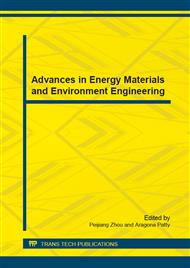p.437
p.442
p.447
p.451
p.455
p.460
p.466
p.470
p.475
Kinetic Analysis for COD Removal in Actual Coking Wastewater through an Micro-Aerobic EGSB Reactor
Abstract:
Treatment of actual coking wastewater considered to be difficult by traditional systems. The present study is related to treatment of actual coking wastewater through microaerobic EGSB reactor. The study showed the EGSB reactor could attain about 75% high COD removal. Increasing Vup could strength COD removal. Moreover, high sludge concentration and profound communal synergism existing within the dense granules were very important. As a result of the kinetic analysis of the EGSB reactor treating actual coking wastewater for COD removal using a modified Stover–Kincannon model, the maximum substrate utilization rate, vmax, half saturation constant, KS, inhibitor constant, KI, actual pollutant removal rate, , and the actual inhibition degree, KS /KI were determined as 2.65×10-3h-1, 39.57mg.L-1, 415.82mg.L-1, 6.7×10-5h-1.mg-1.L and 0.1(before increasing Vup), 7.34×10-3h-1, 19.53mg.L-1, 197.76mg.L-1, 3.7×10-4 h-1.mg-1.L and 0.1(after increasing Vup), and 9.35×10-3h-1, 6.38mg.L-1, 162.81mg.L-1, 1.47×10-3 h-1.mg-1.L and 0.04 (after increasing Vup and X), respectively. The inhibition of toxic contaminants in the actual coking wastewater would cause the decreasing of pollutant removal rate, however, enhancing and X (simultaneously optimizing sludge aggregate structure) could strengthen the performance effect.
Info:
Periodical:
Pages:
455-459
Citation:
Online since:
December 2014
Authors:
Keywords:
Price:
Сopyright:
© 2015 Trans Tech Publications Ltd. All Rights Reserved
Share:
Citation:


